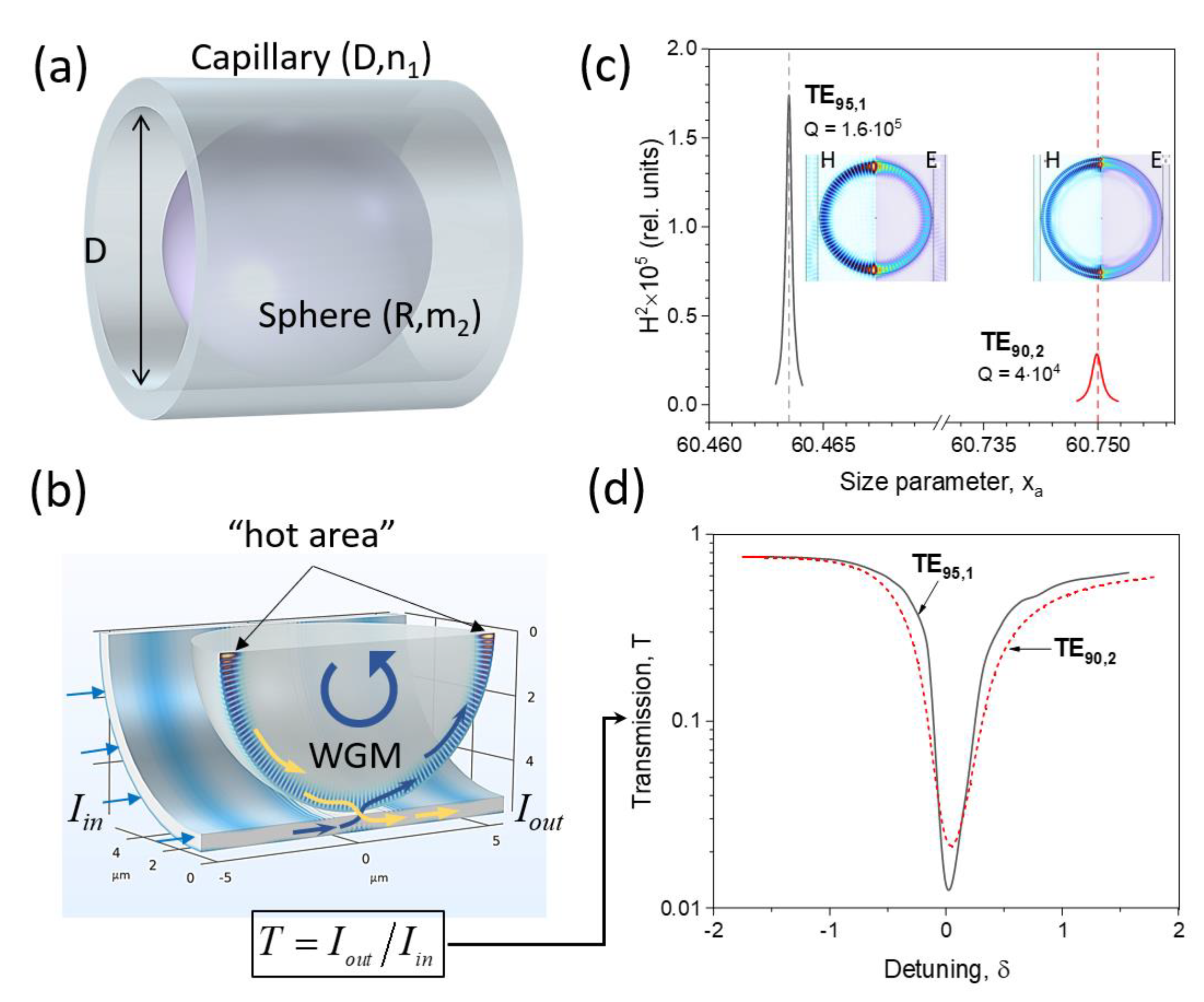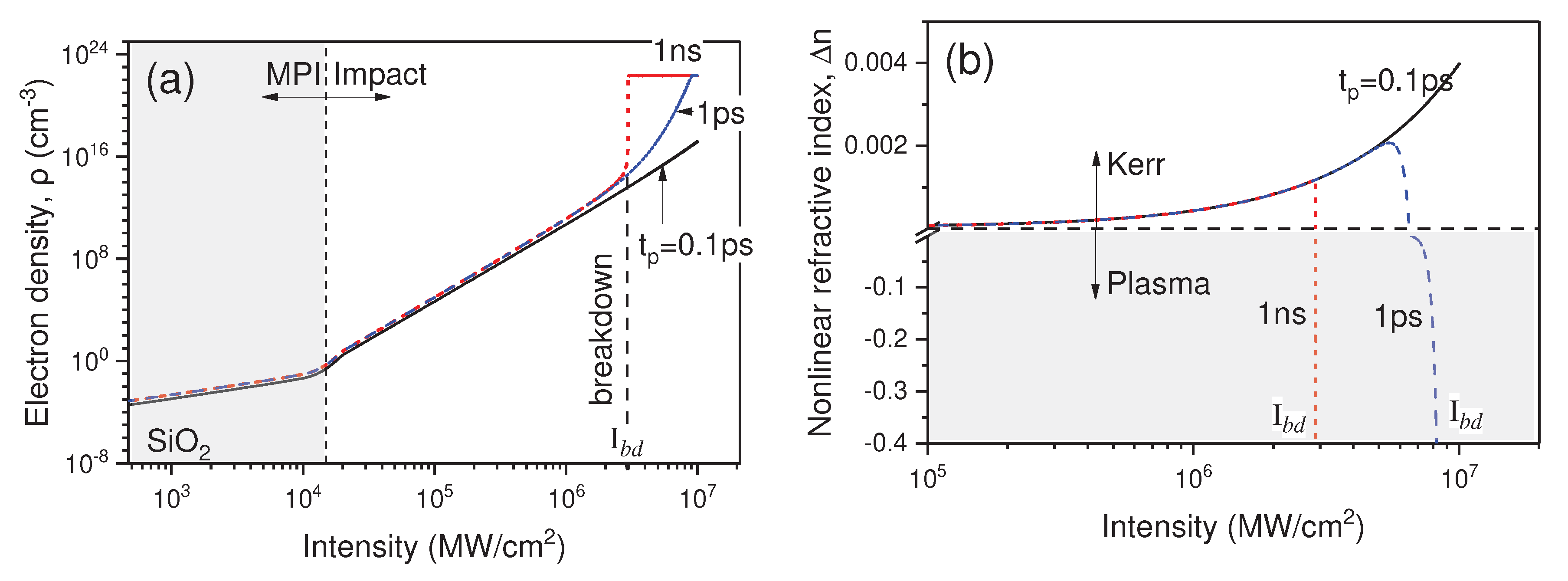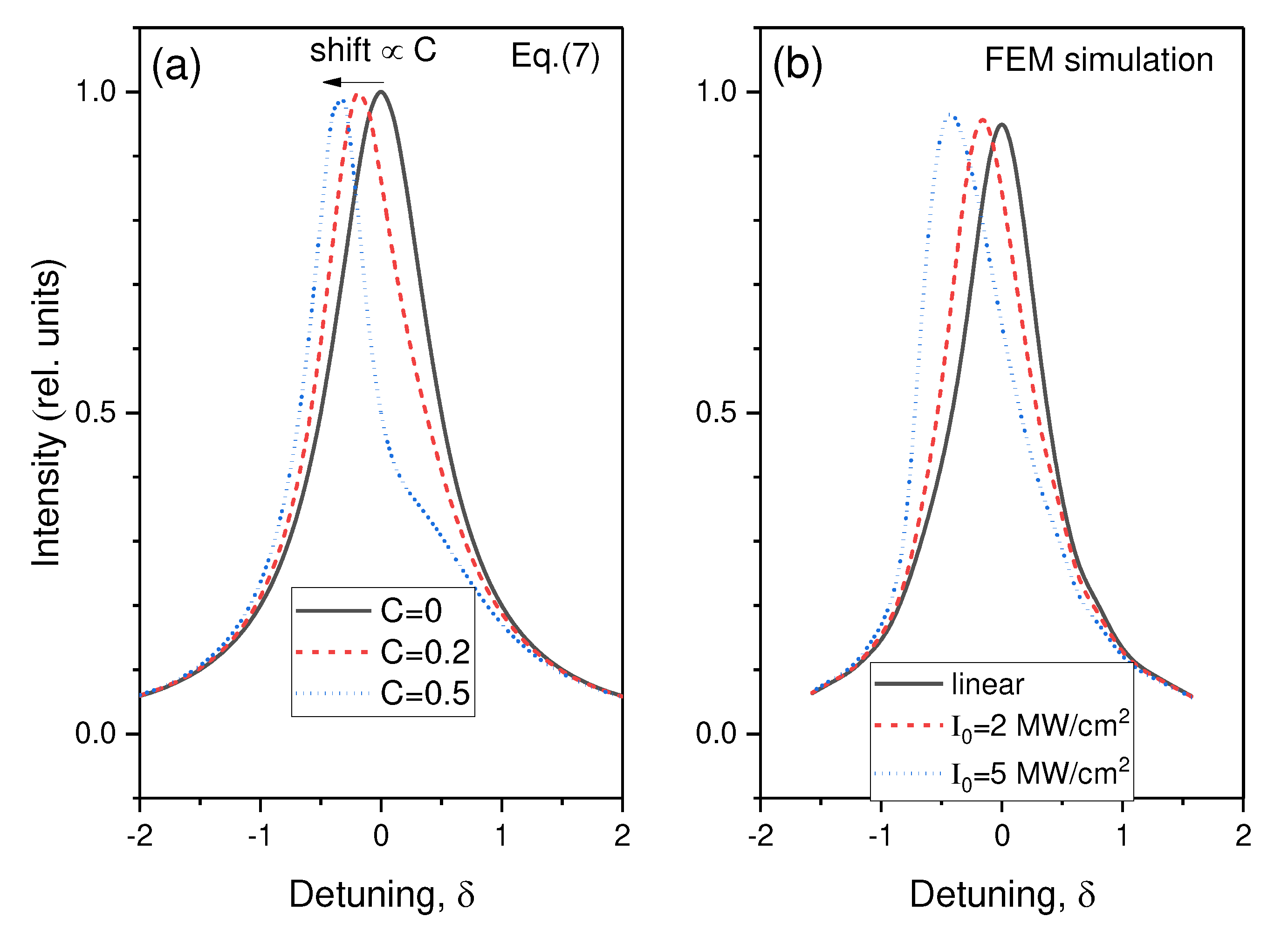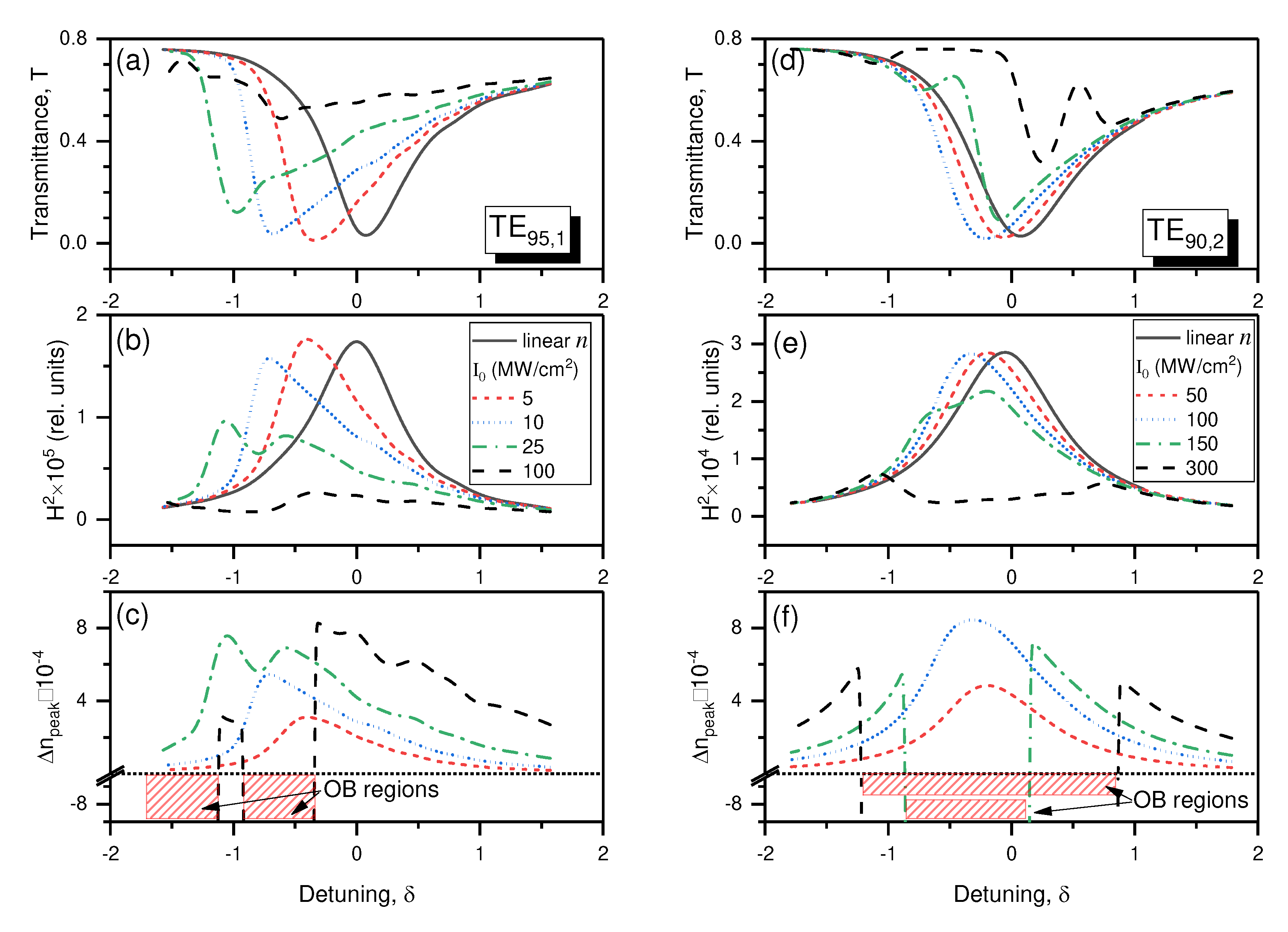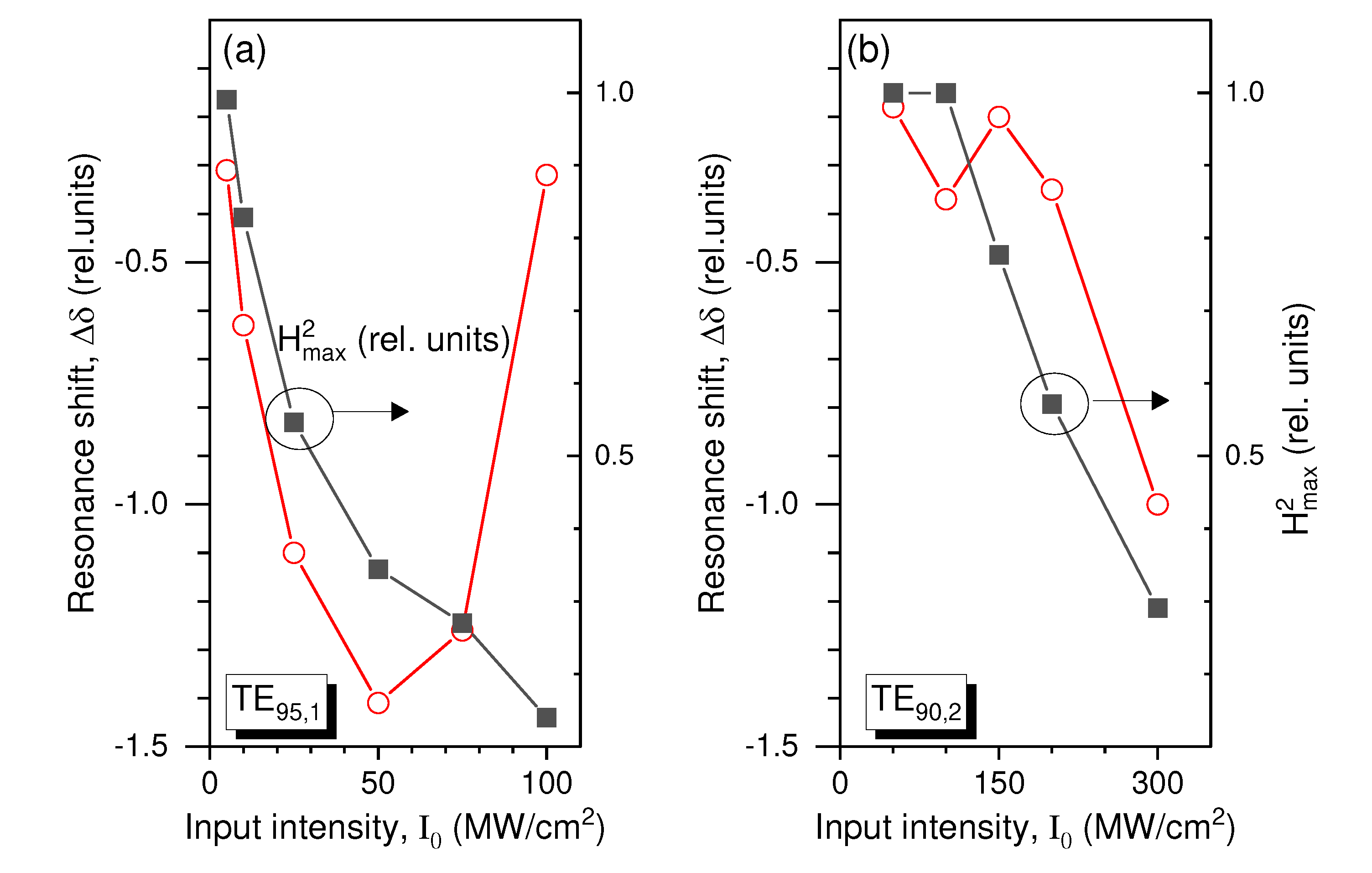I. Introduction
Recently, much research attention has been paid to the study of resonant optical effects in dielectric photonics structures, in particular, microspheres, due to the wide range of extraordinary optical effects exhibited under resonance conditions. This is due to both fundamental interest and numerous potential applications of such resonators. Dielectric wavelength scaled (
mesoscale) particles with Mie size parameter
xa = 2π
R/λ of the order of a few tens (where
R is particle radius, λ is the optical radiation wavelength) occupy a less-explored niche between subwavelength nanoparticles (
xa < 1) and particles which obey the geometrical optics laws (
xa > 100) [
1].
Effective control of optical radiation implies the possibility of manipulating the electric and especially the magnetic components simultaneously. However, in the optical range due to the lowering contribution of electron spin states the magnetic response of dielectric materials found in nature is extremely weak. At the same time, the dielectric particles with a small size parameter and high refractive index can possess a non-zero induced magnetic moment [
2]. Studies in the field of high-quality spherical dielectric resonators have shown that different regimes of light-matter interactions can be significantly enhanced when the WGMs are resonantly excited in the cavity [
3]. Recently, it has been shown that in the so-called super-resonance regime [
4,
5], weakly scattering mesoscale dielectric spheres can support Fano resonances of the internal magnetic and electric fields with very high-quality factor (Q) values.
One of the specific feature of the spatial distribution of resonant optical field in an open spherical cavity is the location of the so-called "hot spots" [
6] at the sphere poles due to the specific behavior of the internal Mie modes with a huge amplification of the intensities of the electric and magnetic components [
4,
5]. The latter is associated with the formation of regions in which the local wave vectors can exceed the wave vector of the incident radiation by orders of magnitude [
7] due to the presence of optical nanovortices, analogous to the generation of strong magnetic fields in microcoils [
8]. Significantly, the presence of nanovortices is not related to the features of the incident optical beam, but is due solely to the scattering of a plane linearly polarized wave, which does not have any intrinsic phase or amplitude singularities. Obviously, at such extremely large fields inside a dielectric microresonator its material can exhibit noticeable optical nonlinearity, in particular due to the optical Kerr effect, thermo-optic effect, radiation pressure, etc. [
9,
10].
The studies on the nonlinear optics in mesoscale dielectric microspheres have a long history and are presented in many publications, e.g., Refs. [
11,
12,
13,
14,
15,
16,
17]. A review of recent advances in the field of nonlinear optics in glass microspheres is presented, e.g., in [
10,
11,
12,
13,
14,
15,
16,
17,
18]. In particular, it was reported that the presence of giant internal field in the hot spots of a dielectric sphere at WGM resonance can lead to a noticeable lowering of the energy threshold for light-induced ionization of the particulate material [
19,
20], which can stimulate the optical breakdown (OB) and effective generation of a supercontinuum [
21,
22]. Meanwhile, the free-electron plasma localized inside the spherical particle in the shadow pole is characterized by the pronounced dynamics and may exhibit a complex spatial shape [
23]. One can also expect that the field enhancement due to high-order Fano resonance [
4] in the above conditions will lead to a reduced ionization threshold similar to that of monomer ionization by high-power femtosecond pulses [
24].
Worthwhile noting, in the most of published works on the impact of the Kerr-type optical nonlinearity on the resonance conditions of high-Q eigenmodes in dielectric spherical particles are studied either the frequency shift of the resonance peak or nonlinear mode splitting, while the overall deformation and possible spoiling of the resonant contour as a whole is not considered. Also, we are not aware of any published works which report the joint action of the Kerr-type nonlinearity and the electron plasma emerged in a dielectric mesoscale sphere on the properties of high-order WGM resonances. The majority of studies known to the authors refer to the electric field resonances, while the magnetic field in a WGM resonance was specially considered only in linear scattering regime for liquid mesoscale particles (water droplets with the size parameter
xa ~ 70) [
4]. The present work is aimed to fill this gap and presents the analysis of the above-mentioned problems.
II. Problem Formulation for a “Resonator-In-Capillary” Model
In the following, the excitation and detection of WGMs in a dielectric microsphere is analyzed according to the popular optical scheme with an evanescent electromagnetic field using a capillary coupled into the WGM resonator (WGMR) [
25]. To this end, we consider the following problem formulation (see, Figure 1a). A dielectric sphere of radius
R having a high refractive index (RI) and extremely small intrinsic absorption is placed inside a glass capillary in such a way that the sphere touches the capillary walls. For simplicity, the particle is illuminated by a laser radiation propagating inside the walls of the capillary without accounting for light reflection from its outlets. Lanthanum doped optical glass (OHARA S-LAM7) having a complex refractive index
m2 = 1.75 -
i⋅10
- [
8] at the wavelength λ = 550 nm [
26] is chosen as the WGMR material. The glass capillary is a hollow annular core fiber (HACF) with a real refractive index
n1 = 1.5 [
27]. In practice, to direct optical radiation mainly into the capillary walls one of its ends is tapered by fusing to a cone and docked to a standard single-mode fiber [
28].
As a result of diffraction coupling of the optical field which leaks out of the capillary walls with the WGMR, inside its volume the optical eigenmodes are excited in the spatial form of an annular field region confined close to the sphere surface (
Figure 1b). The eigenmodes contain the regions with extremely high field intensity ("hot spots"), where favorable conditions are realized for the manifestation of the optical nonlinearity of the particle substance. In turn, this changes the phase-matching conditions of the optical field in resonance and affects the WGM parameters (quality factor, resonance frequency). Obviously, in contrast to the linear case, the WGM properties should depend on the intensity of the excitation field in the capillary.
During the simulations, the spectral range of the input optical radiation was specially chosen to include several neighboring resonances in spherical WGMR with different Q-factors and linewidths.
Thus, in the case under study two resonances are selected: (a) the super-resonance TE95,1 with high quality factor Q = 1.6⋅105 excited at the wavelength λ = 519.585 nm, and (b) the resonant WGM TE90,2 with multiple lower Q- factor, Q = 4⋅104 , at the wavelength λ = 517.13 nm. The spectral positions of the selected resonances are shown in Figure 1c as a function of the dimensionless Mie parameter Mie xa. Practically, the excitation of a WGM resonance is usually detected by the transmission minimum, T = Iout/Iin, of the waveguide coupled to the resonator, as presented in Figure 1d. Here, Iin and Iout are the optical intensities (more exactly, the powers) at the input and output ports of the WGMR, respectively, while on the x-axis in this graph the relative detuning from the resonance frequency ω0 is plotted: , where Γ = ω0/Q denotes the resonance halfwidth.
The optical field coupled with the eigenmode of a spherical particle illuminated through its rim is considered within the stationary problem formulation by the numerical solution of the homogeneous wave equation accounting for resonator medium optical nonlinearity:
where
k0 = 2π/λ is the wave number in free space, and ε′[
E2] = ε + Δε is the nonlinear dielectric permittivity of medium depending on the optical field intensity
E2. The character of the functional dependence ε[
E2] is determined by specific nonlinear processes occurring in the WGMR material in a strong optical field. In transparent dielectrics, such physical processes are primarily cubic optical nonlinearity, manifested as the optical Kerr effect, and photoionization of the medium with the generation of underdense free-electron plasma. Both of these physical mechanisms tend to deform the electronic shells of the atoms, thus changing the polarizability of the medium which is expressed in the appearance of a nonlinear additive Δ
m to the linear refractive index
m:
Here, γ is the parameter of cubic (Kerr) nonlinearity, stays for the optical intensity, is speed of light, while denotes the real part of the complex refractive index. The contribution of plasma nonlinearity to RI additive Δm can be decomposed into real npl and imaginary αpl parts, the latter being the sum of optical losses for molecule photoionization κi and intrinsic plasma absorption κpl: . Clearly, the plasma RI additive is proportional to the spatial distribution of free electron concentration ρe formed as a result of medium photoionization in WGM field.
In turn, the density ρ
e of free-electrons is governed by the kinetic equation accounting for direct multiphoton (MPI) and impact molecule ionization, as well as for the electron number decay due to the recombination with neutrals and ions. In the single ionization approximation, the equation for ρ
e dynamics in an equilibrium plasma has the following form: [
29]
where ν
mpi is the MPI rate,
is the density of the neutral molecules (atoms), ν
i is the impact ionization rate, and
is the free-electron recombination rate which usually is considered as a constant. Equation (3) does not take into account the diffusion of free electrons from the plasma region because the characteristic time of ambipolar diffusion of electrons generated mainly in the “hot spot” area is estimated to be tens of picoseconds, which is an order of magnitude longer than the characteristic time of radiative recombination of plasma free charges, τ
r = 1/ν
r ~ 1 ps.
The photoionization rate ν
mpi of molecules is calculated via the
p-photon absorption process which is characterized by the rate coefficient
and determined by the Keldysh ionization model: [
30]
, where
Ei is the energy bandgap of dielectric. The optical response of plasma is modelled by the Drude model [
31], which neglects the real energy distribution of free electrons and considers some average electron with a constant mean transit time
between collisions. In this case, the frequency of ionization of an atom by electron impact
depends linearly on the product of optical wave intensity
I and the avalanche ionization cross section of the atom σ
c(λ):
. Then, within the Drude medium model the addition to the refractive index due to the plasma nonlinearity is expressed as:
, while the nonlinear absorption due to MPI and plasma "heating" reads as:
. Here, the parameter
is introduced, which defines the critical plasma electron density, above which the plasma becomes completely opaque to optical radiation with the wavelength λ. The main parameters of the numerical model presented above for fused silica in the visible spectral region [
29]
, [
32] are summarized in
Table 1.
The solution to Eq. (3) in the approximation of a step-wise optical pulse of the duration
tp has the following form:
Here, the parameter combines the rates of free electron sources and sink and actually determines the threshold intensity for optical breakdown of medium Ibd providing at .
Indeed, noting that in a dense dielectric at moderate optical intensities the condition ν
mpi << ν
i is usually fulfilled, then from the condition η = 0 one immediately obtains the expression for OB threshold as:
Ibd = ν
rEi/ σ
c , which according to the Table 1 gives the value
Ibd ≈ 2 TW/cm
2 in silica. Worth noting that this value determines the lowest OB threshold in a glass microparticle illuminated by a continuous wave (CW) optical radiation (
tp→∞). For pulsed radiation, the threshold intensity
Ibd increases with laser pulse shortening. For example, for
tp = 1 ns, the calculation of the electron concentration dynamics gives
Ibd ≈ 2.9 TW/cm
2 (
Figure 2a), while for much shorted pulse,
tp = 0.1 ps, the optical breakdown is not realized up to the intensity
Ibd ≈ 100 TW/cm
2. Summarizing, when the intensity of the optical wave in any point of the medium exceeds the specific threshold value,
I >
Ibd (
tp), an avalanche-like growth of free-electron concentration is developed and the appearance of regions with quasi-metal optical properties, i.e., extremely high optical absorption and reflectivity should be expected.
In accordance with the dynamics of optical intensity and plasma electron concentration in the “hot spots” area, the nonlinear additive Δn to the refractive index of medium also changes, as shown in Figure 2b. According to Eq. (2), at small values of optical intensity I, the cubic (Kerr) nonlinearity dominates giving a positive increase of the refractive index Δn ~ I. With the intensity increasing up to the sub-breakdown values, I ~ Ibd, the free-electron density also increases which leads first to compensation of the Kerr additive and then to an avalanche-like fall of Δn in the negative value region.
In our simulation, the computer package COMSOL Multiphysics is used, which performs the numerical solution of the wave equation to obtain the optical fields in a spherical resonator-capillary structure by the finite elements method (FEM). Without limiting the generality of the considered problem, we use an axisymmetric 2D-problem formulation which allows us to model a realistic 3D-problem by calculating the fields in only one half-plane in cylindrical coordinates, . In this case, the entire photonic structure is surrounded by a rectangular region of perfectly absorbing layers (PML) to prevent wave reflection from the outer boundaries of the simulation domain. Input and output of optical radiation are performed through COMSOL coaxial ports by specifying the HE11 fiber mode with circular polarization. For the discretization of all computational domains a triangular mesh is used with the boundary element edges less than λ/20. For the numerical solution of the system of coupled equations (1)-(2), a standard nonlinear solver is chosen based on the Newton's iterative method with damping. The linear step of this solver is carried out using the parallelized method for large sparse systems of algebraic equations (MUMPS). Typically, the reliable convergence of the numerical problem solved is achieved at the number of iterations of about 30 with the optimal parameters of the nonlinear solver.
III. Results and Discussion
Before addressing the results of the numerical simulations on WGM resonances excitation in a cavity with Drude-Kerr-type medium, it is instructive to demonstrate the effect of optical nonlinearity using simple analytical analysis. For simplicity, we consider only the cubic addition to the refractive index of the resonator material as a nonlinear mechanism: Δn(I) = γI.
It is worth noting that the appearance of nonlinear RI additive Δ
n changes the resonance conditions for the eigenmodes and shifts the resonant wavelengths to the Stokes region. Qualitatively, this result can be explained by considering the expression for the resonance size parameter
xa which is inversely proportional to the refractive index of the particle: [
33]
, where
neff =
n + Δ
n, and
l is the mode azimuthal number (e.g.,
l = 95 for TE
95,1 mode). As seen, an increase in the effective refractive index of spherical particle due to the emergence of regions with Kerr nonlinearity (Δ
n <<
n) leads to a proportional redshift of the resonance: Δω/ω
0 ≈ -Δ
n/
n.
In turn, approximating the spectral shape
I(ω) of the resonant contour by a Lorentzian function:
and setting the nonlinear change of the parameter δ as, δ → δ(1 +
f(Δ
n)), one obtains a deformed resonance line in a Kerr-type medium:
Here, is reduced Lorentzian profile, and is the parameter depending on the resonance quality factor Q, resonance intensity Ia, reduced mode volume ξ, and Kerr nonlinearity coefficient γ. Note that the volume ξ occupied by a high-Q WGM usually does not exceed a few percent of the total volume of a spherical resonator.
Figure 3(a) illustrates the deformation of the resonant contour of an eigenmode when increasing the optical nonlinearity of the intracavity medium according to Eq. (6), while Figure 3(b) depicts the results of the numerical solution of Eqs. (1)-(2) in the same intensity range. As seen, the analytical evaluations and exact numerical calculations are in good qualitative agreement. With the increasing of parameter
C, an increasingly pronounced deformation of the resonance spectral contour is observed caused by the peak shifting to the Stokes frequency band with simultaneous broadening of the resonance line, Γ →Γ
C.
Now consider the results of the numerical simulations of WGM spectral contour transformation excited in a spherical resonator in the conditions of optical nonlinearity manifestation of the plasmonic and Kerr types. The capillary wall transmittance
T, magnetic field intensity
H2 (normalized to the initial value), and peak value of nonlinear refractive index Δ
npeak of the resonator material are shown in
Figure 4(a-f) in the dependence on the frequency detuning δ for two eigenmodes of the resonant glass sphere. The optical intensity
I0 of the wave propagating inside the capillary walls and coupling to a WGM is chosen as the dependent parameter.
It follows from the analysis of these figures that at relatively low input radiation intensities, the red shift of the centers and asymmetry of the spectral contours of both WGM resonances are realized, which is in good agreement with the analytical estimates for a purely Kerr medium presented above in Figure 3(a). This indicates that in this intensity range the Kerr addition to the refractive index of the sphere is dominant (
Figure 4c and f).
However, starting from the values I0 = 25 MW/cm2 and 150 MW/cm2 for TE95,1 and TE90,2 eigenmodes, respectively, the spectral contour of WGM acquires significant deformations due to plasma formation in the “hot spot” regions. The emerging electron plasma tends to lower the effective refractive index of the medium and simultaneously causes energy losses of the eigenmode. As a result, intensity dips appear in the Stokes wing of the spectral contour and the magnitude of the magnetic field in resonance decreases (Figure 4b and e).
At even higher input intensities inside the capillary,
I0 = 100 MW/cm
2 and 300 MW/cm
2 for TE
95,1 and TE
90,2, the optical breakdown of the medium is realized at the “hot spots”. In this case, as can be seen in Figure 4, in a certain frequency range shown in the figures by shaded rectangles the nonlinear RI additive Δ
n becomes negative, the optical absorption increases sharply (not shown), and the eigenresonance either practically disappears (
Figure 4a and b) or splits into several weaker sub-resonances (
Figure 4d and e).
Two key parameters of a resonant contour in a nonlinear medium, the frequency shift Δδ from the unperturbed value and magnetic field intensity in resonance , are shown in Figure 5(a) and (b) as the functions of input intensity of the excitation optical field. As seen, as the parameter I0 increases, for both resonance modes there is a tendency for peak intensity decrease and frequency redshift. Obviously, the higher-Q mode, TE95,1, is characterized by a larger-scale change in the parameters Δδ and . Here, the competition between Kerr and plasmonic nonlinearities manifests itself in a nonmonotonic Δδ dependence on the input intensity. Indeed, up to a certain I0 value, I0 ≈ 50 MW/cm2, a monotonic shift of the resonant contour to the Stokes band is caused due to the Kerr effect, and above this I0 value, the parameter Δδ starts to decrease again (in modulus) that indicates the increasing impact of the plasma nonlinearity which imposes the Drude-type polarizability to the resonator medium.
of resonances for (a) TE95,1 and (b) TE90,2 WGMs of a sphere as a function of the input optical intensity.
Our estimates show that under the considered conditions by taking into account nonlinear plasma formation in the “hot spots”, the magnetic flux intensity
B = μ
0H (μ
0 is vacuum permeability) for TE
95,1 super-resonance can reach about 10 Tesla, while for TE
90,2 mode this value is a bit lower,
B ≈ 4 Tesla. Note, that a similar level of magnetic flux strength of about 8 Tesla was reported in [
34] for atomic hydrogen under two-color with 50-fs structured laser pulse excitation at considerably higher laser intensity - 10
15 W/cm
2.
